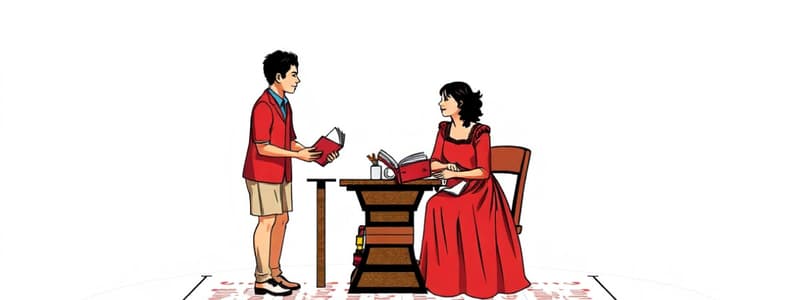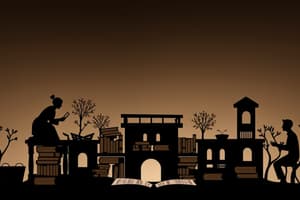Podcast
Questions and Answers
Which of the following is NOT a characteristic of drama?
Which of the following is NOT a characteristic of drama?
- It often explores themes of human nature.
- It is written to be performed.
- It is always written in verse. (correct)
- It typically features dialogue.
Drama is a literary genre that primarily focuses on the written word.
Drama is a literary genre that primarily focuses on the written word.
False (B)
What does the quote from William Shakespeare, "All the world's a stage, And all the men and women merely players," suggest about the nature of drama?
What does the quote from William Shakespeare, "All the world's a stage, And all the men and women merely players," suggest about the nature of drama?
This quote suggests that drama is a reflection of real life, with people playing different roles in their daily lives. It also highlights the theatricality of human existence, with individuals performing and enacting roles. The metaphor of the stage emphasizes the idea that life itself is a performance.
Drama is a literary genre that is written to be ______ before an audience.
Drama is a literary genre that is written to be ______ before an audience.
Match the following genres with their corresponding descriptions:
Match the following genres with their corresponding descriptions:
Which of the following is NOT a type of drama?
Which of the following is NOT a type of drama?
What is the purpose of dialogue in a drama?
What is the purpose of dialogue in a drama?
The "Let’s Step Up!" section at the end of this lesson is likely meant to be a creative writing activity.
The "Let’s Step Up!" section at the end of this lesson is likely meant to be a creative writing activity.
What is the term for a series of scenes in a drama that are related to one another?
What is the term for a series of scenes in a drama that are related to one another?
Dramas are always written in verse form.
Dramas are always written in verse form.
What is the term for a nonsensical drama that employs slapstick humor?
What is the term for a nonsensical drama that employs slapstick humor?
The body of work a drama is based on that contains all the characters' lines, actions, and blocking is called a ______.
The body of work a drama is based on that contains all the characters' lines, actions, and blocking is called a ______.
Match the following literary terms with their definitions:
Match the following literary terms with their definitions:
Which of the following is NOT a common element of drama?
Which of the following is NOT a common element of drama?
The term 'playwright' refers to an author who writes dramas.
The term 'playwright' refers to an author who writes dramas.
What is the purpose of stage directions in a script?
What is the purpose of stage directions in a script?
What defines a tragic hero in a tragedy?
What defines a tragic hero in a tragedy?
Comedy aims to provoke deep thought in the audience.
Comedy aims to provoke deep thought in the audience.
Name a work that is considered a tragedy.
Name a work that is considered a tragedy.
A ______ is characterized by exaggerated emotions in its characters.
A ______ is characterized by exaggerated emotions in its characters.
Which of the following best describes a farce?
Which of the following best describes a farce?
Match the types of dialogue to their descriptions:
Match the types of dialogue to their descriptions:
What is the primary characteristic of musical drama?
What is the primary characteristic of musical drama?
An aside is intended to be heard by all characters on stage.
An aside is intended to be heard by all characters on stage.
Which subgenre of drama focuses on humor and exaggerated situations?
Which subgenre of drama focuses on humor and exaggerated situations?
A play is generally written in prose rather than script form.
A play is generally written in prose rather than script form.
What are the four elements that are crucial for bringing a drama to life?
What are the four elements that are crucial for bringing a drama to life?
A tragic hero has a _______________ that leads to his or her downfall.
A tragic hero has a _______________ that leads to his or her downfall.
Match the type of dialogue with its definition:
Match the type of dialogue with its definition:
Which type of humor is primarily used in a farce?
Which type of humor is primarily used in a farce?
When a character does an _______________, he or she utters lines that only the audience is meant to hear.
When a character does an _______________, he or she utters lines that only the audience is meant to hear.
What is the primary element that differentiates drama from other genres of literature?
What is the primary element that differentiates drama from other genres of literature?
Flashcards
Drama
Drama
A literary genre that presents stories through performance, typically involving dialogue and acting.
Elements of Drama
Elements of Drama
Key components that make up a drama, including characters, plot, dialogue, and setting.
Subgenres of Drama
Subgenres of Drama
Different categories within drama, such as tragedy, comedy, and melodrama.
Dialogue
Dialogue
Signup and view all the flashcards
Literary Elements
Literary Elements
Signup and view all the flashcards
Performance
Performance
Signup and view all the flashcards
Relatability in Drama
Relatability in Drama
Signup and view all the flashcards
William Shakespeare
William Shakespeare
Signup and view all the flashcards
Main Genres of Literature
Main Genres of Literature
Signup and view all the flashcards
Types of Drama
Types of Drama
Signup and view all the flashcards
Monologue
Monologue
Signup and view all the flashcards
Soliloquy
Soliloquy
Signup and view all the flashcards
Aside
Aside
Signup and view all the flashcards
Tragic Hero
Tragic Hero
Signup and view all the flashcards
Tragedy
Tragedy
Signup and view all the flashcards
Comedy
Comedy
Signup and view all the flashcards
Musical Drama
Musical Drama
Signup and view all the flashcards
Farce
Farce
Signup and view all the flashcards
Melodrama
Melodrama
Signup and view all the flashcards
Literary language
Literary language
Signup and view all the flashcards
Nonliterary language
Nonliterary language
Signup and view all the flashcards
Dramatists
Dramatists
Signup and view all the flashcards
Script
Script
Signup and view all the flashcards
Act
Act
Signup and view all the flashcards
Scene
Scene
Signup and view all the flashcards
Study Notes
21st Century Literature of the Philippines and the World - Study Notes (Grade 11/12 Unit 3)
- Lesson 3.4: Drama - This lesson focuses on the literary genre of drama.
- Introduction - Many people enjoy movies, plays, and TV series because they reflect real life. Students will learn about drama, its elements, and subgenres.
- Objectives - Students will be able to define drama, distinguish it from other genres, identify elements of drama, and analyze reading selections according to those elements.
- DepEd Competencies - Students will be able to explain literary elements, genres, and traditions. They will understand literary uses of language and distinguish them from non-literary uses; analyze figures of speech and literary techniques.
- Warm-Up - Students should recall a play or movie they watched. The goal is to activate prior knowledge about what made that experience engaging/memorable to them.
- Learn About It - Drama is a verse or prose form intended for performance on stage. Authors of drama are called dramatists or playwrights. The elements of drama are similar to fiction.
- Vocabulary - Definitions for terms like: scene, act, script, farce, soliloquy.
- Essential Question - Students will consider why people relate to literature.
- Types of Drama:
- Tragedy - The central character in a tragedy has a fatal flaw that leads to their downfall. Examples include plays by Shakespeare, Aeschylus, Sophocles, and Euripides.
- Comedy - Comedic plays aim to make audiences laugh. They often have witty remarks and unusual circumstances. Classic examples are plays by Shakespeare, such as The Taming of the Shrew and The Merchant of Venice.
- Musical Drama - Characters in these dramas sing and dance, often presenting a variety of themes, from serious to comedic.
- Farce - A nonsensical drama using slapstick humor. Situations are absurd and actions are often lively. An example given was The Flying Doctor by Molière.
- Melodrama - Characterized by exaggerated emotions in various situations.
- Dialogues - Dialogue is the lifeblood of drama, conveying the story's details through character speech. Dialogues can take many different forms (conversations between two or more characters).
- Monologue, Soliloquy, Aside: Detailed descriptions of these specific types of dialogue.
- Let's Check In - Exercises to ensure understanding of the subgenres and significant elements of drama.
- Key Points - Drama is a key literary genre with varied types (tragedy, comedy, farce, etc.). The content is typically presented in dialog form.
- Check Your Understanding - A series of questions and blank fill to assess learning on specific drama concepts.
- Let's Step Up! - Activity to apply learning and potentially perform a one-act play.
- Photo Credit - Attribution of image in the reference material.
- Bibliography - A listing of the sources consulted for this study material.
Studying That Suits You
Use AI to generate personalized quizzes and flashcards to suit your learning preferences.




